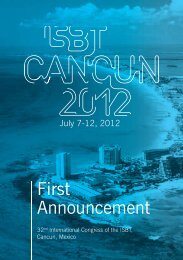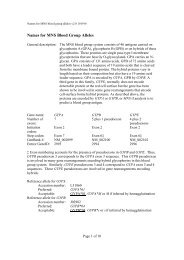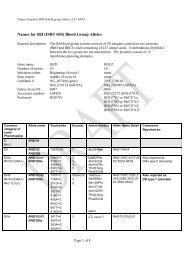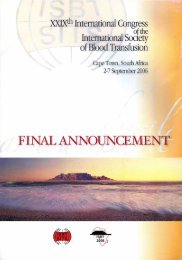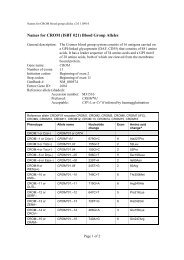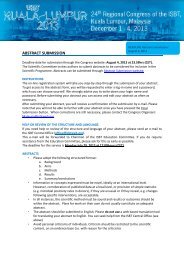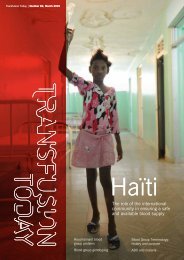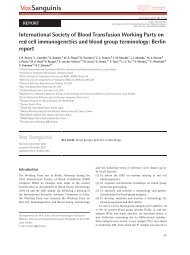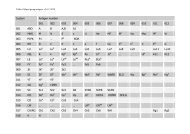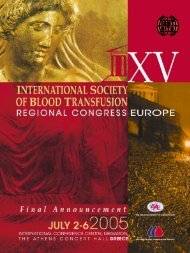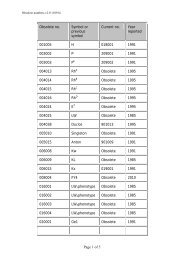Guidelines for the Use of RFID Technology in Transfusion Medicine
Guidelines for the Use of RFID Technology in Transfusion Medicine
Guidelines for the Use of RFID Technology in Transfusion Medicine
Create successful ePaper yourself
Turn your PDF publications into a flip-book with our unique Google optimized e-Paper software.
24 Guidel<strong>in</strong>ePJM StackTag Ò , Magellan <strong>Technology</strong> Pty Ltd, Sydney, Australia1. Is an <strong>RFID</strong> tag that can be operated <strong>in</strong> stacks <strong>of</strong> many hundred <strong>RFID</strong> tags without separation2. Is unique and does not depend on tuned <strong>RFID</strong> tags to operate3. Chips and <strong>in</strong>lets use a unique method to operate on low field strength4. Inlets are not designed <strong>for</strong> resonance frequency (most tags have a self-resonance frequency between 14 and 70 MHz)5. StackTag <strong>in</strong>lets do not detune by o<strong>the</strong>r <strong>RFID</strong> tags or materials and will operate even on metal or under water6. Inlets are designed ei<strong>the</strong>r <strong>for</strong> range or <strong>for</strong> maximum stackability7. Inlet design is easy and as tags are robust to any detun<strong>in</strong>g exist<strong>in</strong>g <strong>in</strong>let <strong>for</strong>m factors can be used <strong>for</strong> easy pilot project<strong>in</strong>stallationPortal – A door or o<strong>the</strong>r po<strong>in</strong>t <strong>in</strong> a facility surrounded by fixed <strong>RFID</strong> readers to identify and track <strong>the</strong> flow <strong>of</strong> product. Load<strong>in</strong>gdock doors are a typical example.Reader – Also known as an <strong>in</strong>terrogator. Typically a network-based device and antenna configuration, which reads <strong>the</strong><strong>in</strong><strong>for</strong>mation conta<strong>in</strong>ed on an <strong>RFID</strong> tag. In passive operations, <strong>the</strong> reader supplies <strong>the</strong> tag with power. Readers can be fixedposition <strong>for</strong> load<strong>in</strong>g dock door or o<strong>the</strong>r portal applications, or embedded <strong>in</strong>to mobile devices <strong>for</strong> <strong>in</strong> store or exception report<strong>in</strong>grequirements.Rollout – When pilots provide sufficient evidence <strong>of</strong> a strong return on <strong>in</strong>vestment, companies are expected to deploy (rollout)<strong>the</strong> technology <strong>in</strong>to greater parts <strong>of</strong> <strong>the</strong>ir supply cha<strong>in</strong>. This process is expected to result <strong>in</strong> significant growth <strong>for</strong> <strong>the</strong><strong>RFID</strong> <strong>in</strong>dustry.Smart Storage – In this context <strong>the</strong> authors mean smart solutions <strong>in</strong> storages, which allow <strong>the</strong> quick and easy f<strong>in</strong>d<strong>in</strong>g <strong>of</strong> adef<strong>in</strong>ite unit <strong>in</strong> storage rooms or cab<strong>in</strong>ets.Tag – Also referred to as transponder or transponder tag, which is typically affixed to an item <strong>for</strong> track<strong>in</strong>g purposes. Composed<strong>of</strong> a semi-conductor chip and antenna held toge<strong>the</strong>r <strong>in</strong> a substrate. Each tag has a manufacturer <strong>in</strong>stalled unique identificationnumber as well as additional few bits to many kilobits <strong>of</strong> <strong>in</strong>cremental memory. Passive tags receive energy from<strong>the</strong> reader, while active tags have an <strong>in</strong>ternal power supply.Track and Trace - Involves controll<strong>in</strong>g <strong>the</strong> shipp<strong>in</strong>g and receiv<strong>in</strong>g process <strong>for</strong> medical devices, as well as manag<strong>in</strong>g assetsand <strong>in</strong>ventories with<strong>in</strong> healthcare facilities.UID – Unique Identification is a US DoD-based number<strong>in</strong>g scheme to identify a broad range <strong>of</strong> high-value assets.UHF (Ultra High Frequency) <strong>RFID</strong> – <strong>RFID</strong> products that use <strong>the</strong> 868–950 MHz frequency band, which is regulated by governments.This frequency allows read ranges <strong>of</strong> 8–30 feet (2–4 times that <strong>of</strong> HF), but can be heavily affected by environmentalfactors, <strong>in</strong>clud<strong>in</strong>g liquids and metals, mandated by Wal-Mart and <strong>the</strong> US DoD <strong>for</strong> supply cha<strong>in</strong> applications.Write Once Read Many (WORM) – <strong>Use</strong>d to describe an <strong>RFID</strong> tag that allows only one set <strong>of</strong> data to be written on to it. It istypically used <strong>in</strong> applications where security is a concern.Ó 2010 The Author(s)Journal compilation Ó 2010 International Society <strong>of</strong> Blood <strong>Transfusion</strong>, Vox Sangu<strong>in</strong>is (2010) 98 (Suppl. 2), 1–24



